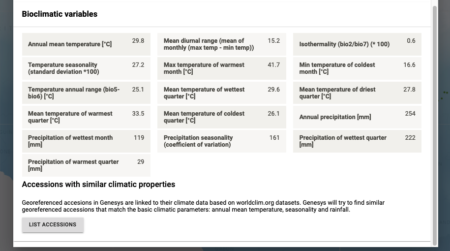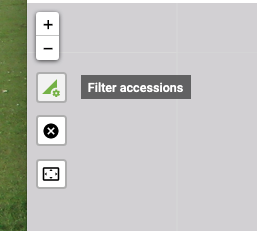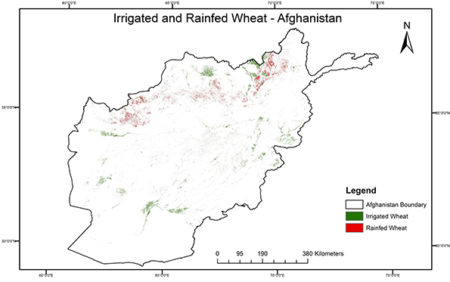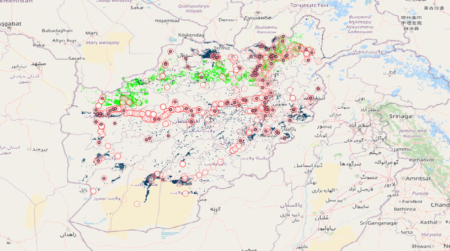- Training courses on multilateral environmental agreements, including CBD and Plant Treaty.
- CGIAR dashboard on the Genebank Platform. More data here.
- Some of the above are included in this list of the world’s most high profile genebanks.
- The latest spatial crop data from CGIAR. Useful for genebanks, among other things.
- Protecting fruit intellectual property. Wait, that didn’t come out right.
- I guess this fruit is next.
- Sikkim’s agricultural diversity as colours on a palette.
- Lavender is a nice colour, whether in France or Bulgaria.
- Book on nation-building through agricultural biodiversity. Bulgarians unavailable for comment.
- Poppy diversity being helped by solar panels to build something or other in Afghanistan.
- Palestinian paean to the bitinjan. Jeremy goes to town on it in his latest newsletter.
A Genesys use case for the weekend
I figured today I’d tweet about a cool new feature of Genesys, the online portal to genebank accessions. And I did, but then I thought I should really put it on here too. So here goes.
The use case I’ll consider today is:
I have an accession I like, and I know where it was collected. Show me all other accessions anywhere in the world that come from a roughly similar climate.
Here’s what you do. Hang on to your butts.
When you have selected the accession you like in Genesys, go to Map, and look for this on the far left.

Click on Show Climate…
Then click on your accession on the map. You’ll get a summary description of the climate at that point.

If you then click on List Accessions (bottom left hand corner), you’ll get a list of all accessions from places which are roughly comparable in climate to that of the accession which you clicked. I can explain how that’s calculated separately if people are interested.
Or, you can choose one of those bioclimatic variables listed, decide on some max and min values, go to Filter Accessions on the left of the map, and insert your chosen values in the appropriate place on the menu that should appear (scroll down).

Click on Apply Filters at the top of the menu, and there’s a list of accessions again, this time from places with climates within your chosen limits.
Let me know in comments if you have any questions, or indeed ideas for improvement.
Here’s a PDF of the Twitter thread.
Brainfood: Biodiversity targets, Image software, Potato efficiency, Cassava cyanide, Popcorn, Payment for agrobiodiversity, Walnut conservation, Grapevine leaves, Pigeonpea haplotypes, Chakras, Diet & diversity, Seed activism, Seed longevity
- Genetic diversity targets and indicators in the CBD post-2020 Global Biodiversity Framework must be improved. Better than accession numbers? Well, yeah, but will it matter?
- FIELDimageR: An R package to analyze orthomosaic images from agricultural field trials. Extract plot-level results from your drone shots, automagically.
- Radiation Interception, Conversion and Partitioning Efficiency in Potato Landraces: How Far Are We from the Optimum? Quite far, but perhaps more interestingly you can predict tuber yield from time-series aerial imagery. Which means the above could come in useful.
- Genetic architecture and gene mapping of cyanide in cassava (Manihot esculenta Crantz.). High cyanide alleles in 2 major genes mainly found along Amazonian rivers and in coastal areas of Brazil. Drones unavailable for comment.
- Relationships among American popcorn and their links with landraces conserved in a microcenter of diversity. Did the diverse popcorns of southern Brazil derive from local diversification or independent local domestication? More work needed. Anyone going to mash this up with the cassava result above?
- Payments for agrobiodiversity conservation services: An overview of Latin American experiences, lessons learned and upscaling challenges. 5 ha of each of 100 varieties will cost you US$70,000 p.a. at a 5% discount rate. Bargain.
- Diversity Under Threat: Connecting Genetic Diversity and Threat Mapping to Set Conservation Priorities for Juglans regia L. Populations in Central Asia. Ex situ where threat level from climate change is severe, in situ where threat level due to climate change is minor, assisted natural regeneration where threat level from climate change is minor but severe from other things, like overgrazing. No word on payments for ecosystem services rendered.
- Composite modeling of leaf shape across shoots discriminates Vitis species better than individual leaves. Fancy maths used to composite leaf shapes along a shoot as a way of telling species apart.
- Superior haplotypes for haplotype‐based breeding for drought tolerance in pigeonpea (Cajanus cajan L.). From 10 genes and about 300 genotypes to 17 accessions with 4 superior haplotypes.
- Create Space for Indigenous Leadership to Preserve Agricultural Biodiversity. In the Ecuadorian Amazon, cacao production for cash is not driving down agrobiodiversity.
- Conceptual Links between Landscape Diversity and Diet Diversity: A Roadmap for Transdisciplinary Research. There are 4 different pathways whereby diverse forested landscapes can lead to diet diversity.
- ‘Keeping seeds in our hands’: the rise of seed activism. While the formal sector is still arguing about farmers’ rights, activists have moved the paradigm to seed sovereignty.
- Thirty-year monitoring and statistical analysis of 50 species’ germinability in genebank medium-term storage suggest specific characteristics in seed longevity. Huge dataset reveals some geographic variation in seed longevity within crops, among other things.
Exploring Afghanistan’s wheat
There’s a new paper on the geographic distribution of wheat cultivation in Afghanistan. You can explore the data online. But here’s the bottom line, the paper’s Fig. 9.
I downloaded the cultivated wheat data from Genesys and imported everything into QGIS to play around with. That’s almost 5,000 genebank accessions, about half of which are geo-referenced. Here’s the result.
Circles are all cultivated wheats, red dots everything that is not bread wheat. Note the irrigated areas (dark blue) are more likely to have modern varieties, and that the area of rainfed cultivation (bright green) varies considerably from year to year with precipitation. Probably some more collecting to be done then, in particular in the rainfed northwestern region, based on this map. But I’m not going to bet on that until I see whereVIR’s 570-odd Afghan wheats were collected.
Brainfood: Cover crops, Forest management, Mixtures, Diverse landscapes, Ethiopia and CC, Mapping settlements, Fonio, Peach, Aging seeds, African diversity, Svalbard, Vegetables
- The hidden land use cost of upscaling cover crops. You’d need to devote 4% of the arable maize area of the US to cover crop seed production to have enough cover crop seed for the maize cultivated area. That’s a lot. The answer: better cover crop genetics and agronomy.
- The first rapid forest inventory and resource use assessment of Dashtijum Nature Reserve, Tajikistan: a mixed methods approach. Fancy maths says you need to restrict grazing in these fancy walnut-fruit forests to prevent further degradation.
- Towards intercrop ideotypes: non-random trait assembly can promote overyielding and stability of species proportion in simulated legume-based mixtures. In silico modelling shows that not all mixtures outyield pure stands, but it’s hard to predict which will.
- Fixing our global agricultural system to prevent the next COVID-19. Beyond the land sparing vs sharing dichotomy, to multifunctional landscapes, supported by policies and markets.
- The role of climate in the trend and variability of Ethiopia’s cereal crop yields. Higher temperatures during 1979–2014 correlated with lower yields in much of the high potential area. So, trouble ahead.
- Precise mapping, spatial structure and classification of all the human settlements on Earth. Because they’re there, that’s why.
- Genetic Resources and Varietal Environment of Grown Fonio Millets in West Africa: Challenges and Perspectives. Lots of work to be done by enterprising breeders.
- Genetic Resources, Breeding Programs in China, and Gene Mining of Peach: A Review. Lots of work has been done by enterprising breeders.
- Patterns of mitochondrial DNA fragmentation in bread wheat (Triticum aestivum L.) seeds under ex situ genebank storage and artificial aging. Possible biomarker for seed viability, but differences between natural and artificial aging.
- Ancient genomes reveal complex patterns of population movement, interaction, and replacement in sub-Saharan Africa. Present day hunter-gatherers represent a contraction of a previously widespread human population, which interacted in complex ways with subsequent waves of pastoralists and farmers.
- The past shall not begin: Frozen seeds, extended presents and the politics of reversibility. So Svalbard apparently represents the politics of reversibility made concrete. Literally.
- The Role of Vegetable Genetic Resources in Nutrition Security and Vegetable Breeding. How about reversing the slide of traditional vegetables, eh? Those enterprising breeders needed again.

